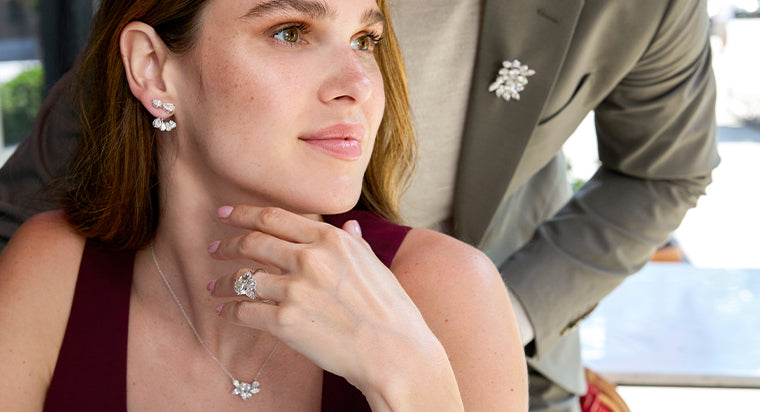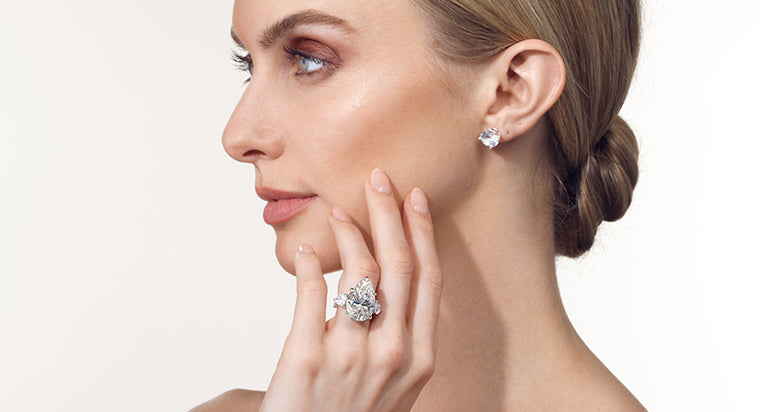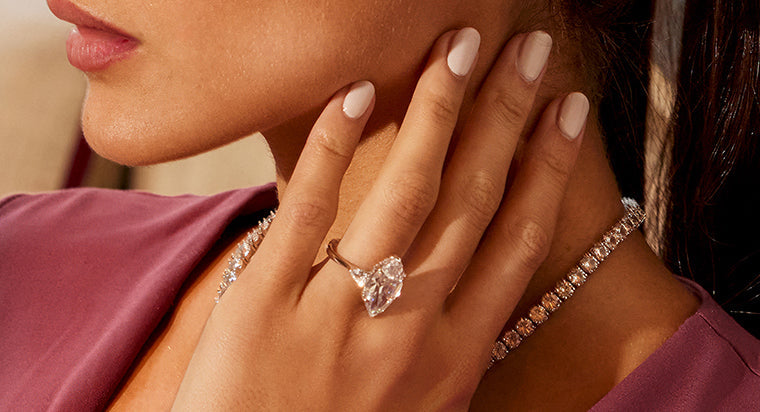Buying Guide for Asscher Cut Diamond Engagement Rings

If you love timeless sparkle with a vintage twist, Asscher-cut diamond engagement rings might be the perfect choice. Celebrated for their geometric symmetry and captivating depth, these diamonds make an elegant, refined statement.
Whether you're actively ring shopping or just starting to explore ring styles, this guide will walk you through the distinct features of the Asscher cut—along with key insights on settings, metal choice, and shopping tips to help you make a confident choice.
TABLE OF CONTENTS
What Makes the Asscher Cut Special?
The Asscher cut is a step-cut diamond with a square shape and cropped corners– think of it as a more structured, squared-off cousin of the emerald-cut. It’s known for its Art Deco flair and mesmerizing “hall of mirrors” effect, created by its deeply layered facets. While both brilliant cut and asscher-cut come with 58 facets, the former maximises sparkle through intricate facet patterns while the asscher cut emphasizes clarity, depth, and symmetry and reflects light elegantly. The end result? A beautiful diamond that feels both vintage and modern at once.
A Little History Lesson on Asscher Cuts
Asscher-cut diamonds may radiate old-world charm, but this diamond cut is not that old!
Yep..They were first developed in 1902 by the Asscher Brothers of Holland. The cut soon rose to fame during the Art Deco era of the 1920s and 1930s, when its clean lines, symmetry, and architectural elegance perfectly matched the design sensibilities of the time. It was one of the first diamond cuts to be patented, and its influence was so strong that it became a symbol of vintage luxury. While modern Asscher cuts are slightly more brilliant than the original design—thanks to updated facet structures—they still retain the vintage glamour and old-world sophistication that made them iconic.
Pros and Cons of Asscher Cut Diamonds
Like any diamond shape, the Asscher cut comes with its own set of advantages and considerations. One of its biggest strengths is that it offers a one-of-a-kind vintage look.
The step-cut facets and symmetrical shape create a mesmerizing "hall of mirrors" effect that’s both subtle and striking. The asscher-cut draws the eye inward, with its regal and hypnotic sparkle. Its clean lines and cropped corners also make it a durable choice– it’s less prone to chipping and snagging onto clothes, making it an excellent choice for engagement rings.
However, because of their large, open facets and step-cut design, Asscher-cut diamonds tend to show inclusions and color more easily than brilliant cuts. This means you’ll likely need to invest in stones of higher clarity and color grade for that visually flawless look. Additionally, it also tends to show less fire and sparkle than cuts like the round brilliant, making it a better match for someone who appreciates subtlety and structure over brilliance. Still, for those who admire timeless elegance and old-world glamour, the Asscher cut is a beautiful choice.
Diamond Quality: What to Look For When Buying Asscher Cut Diamonds?
Both natural and lab-grown asscher-cut diamonds are measured for quality using the 4Cs (carat, cut, color, and clarity). There are a few things to keep in mind:
- Step cuts don’t mask color as well as brilliant cuts, so the hue of your diamond is more noticeable—especially in white metal settings like platinum or white gold. We recommend going for G-H color grade (near colorless) for that white, icy look.
- Because Asscher cuts have large, open facets and a window-like appearance, inclusions are more easily visible. For that reason, it’s best to opt for a higher clarity grade—ideally VS2 or better—to ensure your diamond appears eye-clean.
- We recommend looking for symmetric stones where the shape and alignment of a diamond’s facets look uniform.
- An ideal length-to-width ratio for an asscher-cut diamond falls between 1.00 – 1.03, which gives the stone a perfectly square-shaped look—the signature shape of this cut. However, if you prefer a slightly elongated look, a ratio between 1.40 and 1.50 will create a more rectangular silhouette, though that leans closer to an Emerald cut in appearance.
- Asscher-cut diamonds tend to appear smaller face-up compared to other shapes of the same carat weight. This is because much of the diamond’s weight is concentrated in its deeper pavilion, or bottom half, rather than spread across the top. If you're shopping online and can’t view the diamond in person, keep this in mind when evaluating size—it may be worth going slightly larger in carat weight to achieve the visual impact you're after.
Types of Asscher Cut Rings
Now, let’s look at a few popular settings for Asscher-cut engagement rings:
- Classic Solitaires: A single Asscher-cut diamond is mounted on a metal band, putting all the focus on the stone’s beauty. This is perfect if you want something timeless and minimal. Pro tip: Choose a diamond of high quality in terms of cut, clarity, and color grade, as all the focus will be on the diamond in a solitaire setting.
- Halo Designs: In this setting, the center stone is surrounded by a halo of smaller diamonds, visually enhancing the size of the central diamond and adding extra brilliance to the ring. If you love a bold, standout ring, then this is the style for you. Pro tip: Opt for a square or octagonal halo to enhance the Asscher cut’s symmetry—avoid round or ornate halos that disrupt its clean, structured look.
- Vintage-Inspired Styles: Asscher cut diamonds pair beautifully with vintage details like milgrain, filigree, and baguette side stones– perfect for the sentimental brides who love rings that tell a story. Pro tip: Choose a design where the intricate accents enhance, rather than overpower, the Asscher’s clean lines and mesmerizing depth.
- Three-Stone Rings: Looking for a meaningful ring? Then go for a three-stone ring. Symbolizing the past, present, and future, this design typically features an asscher-cut diamond in the center with smaller diamonds on either side for a beautifully balanced look. Pro tip: Stick to side stones with clean lines and similar faceting styles to maintain visual harmony and keep the focus on the Asscher’s architectural brilliance.
Choosing the Right Metal
Once you have a good idea about the type of style you’d like, it’s time to decide on the metal.
For a sleek, modern aesthetic that emphasizes the cut’s crisp lines and clarity, cool-toned metals like platinum or white gold are ideal—they enhance the diamond’s brightness and showcase its “hall of mirrors” effect beautifully. Yellow or rose gold, on the other hand, adds a warm, vintage-inspired contrast that complements the cut’s Art Deco roots.
Budget & Sustainability Tips
If you're shopping with a budget in mind or want to prioritize sustainability, consider a lab-grown asscher-cut diamond. Lab diamonds have the same physical and chemical makeup as mined ones but come at a more affordable price point and with a smaller environmental footprint. That means you can get a bigger or higher-quality stone without compromising your values—or your wallet.
Conclusion
Asscher-cut engagement rings are elegant, bold, and full of personality. They’re perfect for someone who wants a sparkler with a vintage vibe and unique charm. Asscher cuts are also ideal for someone who wants a unique-looking engagement ring. When shopping, consider the cut quality, clarity, setting style, and metal that best fit your lifestyle and budget. With the right combo, you’ll have a ring that feels like you and looks stunning for a lifetime.
FAQs
Is an Asscher-cut diamond good for engagement rings?
What are prong settings?
What setting is best for an Asscher cut?
Why are lab diamonds called sustainable?
Why are lab diamonds more affordable?









